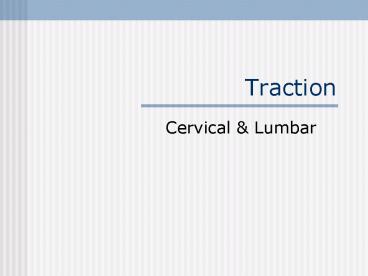Traction - PowerPoint PPT Presentation
1 / 21
Title: Traction
1
Traction
- Cervical Lumbar
2
Traction
- Application of a longitudinal force to the spine
associated structure - Can be applied with continuous or intermittent
tension - Continuous small force for extended time (over
hours) - Sustained - small force for extended time (45
min. or less) - Intermittent alternates periods of traction
relaxation (most common) - May be applied manually or with a mechanical
device
3
Indications
- Muscle spasm
- Certain degenerative disk diseases
- Herniated or protruding disks
- Nerve root compression
- Facet joint pathology
- Osteoarthritis
- Capsulitis of vertebral joints
- Anterior/posterior longitudinal ligament pathology
4
Cervical Disc Herniation
5
Lumbar Disc Herniation
6
Contraindications
- Unstable spine
- Diseases affecting vertebra or spinal cord,
including cancer meningitis - Vertebral fractures
- Extruded disk fragmentation
- Spinal cord compression
- Conditions in which flex. /or ext. are
contraindicated - Osteoporosis
7
Precautions
- Condition should have been evaluated by a
physician - Physicians Orders
- Close monitoring of patient should be performed
throughout treatment - Can cause thrombosis of internal jugular vein if
excessive duration or traction weight is used
8
Cervical Traction
- Application of a longitudinal force to the
C-spine structures - Tension applied can be expressed in pounds or
of patients body weight. - At 7 of patients body weight, vertebral
separation begins - Human head accounts for ?8.1 of body weight
(8-14 lbs.) - Greater amount of force is needed widen areas
- You want force to be about 20 of body weight
9
Cervical Traction Positioning
- Seated a greater force is needed to apply the
same pressure (due to gravity) than if supine - Supine support lumbar region (bend knees, use
knee elevator, or hang lower legs over end of
table place feet on chair) allows musculature
to relax
10
Effects of Cervical Traction
- Reduces pain paresthesia associated w/ n. root
impingement m. spasm - Reduces amount of pressure on n. roots allows
separation of vertebrae to result in
decompression of disks.
11
Effectiveness of Cervical Traction
- Cervical traction has been linked to 5 mechanical
factors - Position of the neck
- Force of applied traction
- Duration of traction
- Angle of pull
- Position of patient
12
Cervical Treatment Set-up
- Neck placed in ?25-30 flexion
- Straightens normal lordosis of C-spine
- Must have at least 15 flexion to separate facet
joint surfaces - Body must be in straight alignment
- Be aware that C-spine traction can cause residual
lumbar n. root pain if improperly set up. - Duration 10-20 minutes most common
13
Cervical Treatment Set-up
- Remove any jewelry, glasses, or clothing that may
interfere - Lay supine, place pillows, etc. under knees
- Secure halter to cervical region placing pressure
on occipital process chin (minor amount) - Align unit for 25-30 of neck flexion
- Remove any slack in pulley cable
- OnOff sequence 31 or 41 ratio
14
Cervical Treatment
- Following treatment, gradually reduce tension
gain slack - Have patient remain in position for a few minutes
after treatment
15
Lumbar Traction
- To be effective, lumbar traction must overcome
lower extremity weight (¼-½ of body weight) - Friction is a strong counterforce against lumbar
traction - Split table is used to reduce friction
16
Lumbar Traction
- Mechanical traction
- Motorized unit
- Self-administered Autotraction
- Manual traction
- Belt
- Thoracic stabilization harness
- Pelvic traction harness
- Clinicians body weight
17
Lumbar Traction
- Tension
- Approximately ½ of body weight
- Published literature 10-300 of patients body
weight - Patient Position Angle of Pull
- Should maximize separation elongation of target
tissues - Prone or Supine depends on
- Patient comfort
- Pathology
- Spinal segments structures being treated
18
Lumbar Traction - Patient Position
- Supine positioning
- Tends to increase lumbar flexion
- Flexing hips from 45? to 60? increases laxity in
L5-S1 segments - Flexing hips from 60? to 75? increases laxity in
L4-L5 segments - Flexing hips from 75? to 90? increases laxity in
L3-L4 segments - Flexing hips to 90? increases posterior
intervertebral space - Prone Position
- Used when excessive flexion of lumbar spine
pelvis or lying supine causes pain or increases
peripheral symptoms
19
Lumbar Traction Angle of Pull
- Anterior angle of pull increases amount of lumbar
lordosis - Posterior angle of pull increases lumbar kyphosis
- Too much flexion can impinge on the posterior
spinal ligaments - Optimal position angle of pull
- Often derived by trial error
- Depends on patient pathology of injury
20
Lumbar Treatment Set-up
- Calculate body weight
- Apply traction stabilization harness
- Position on table, drape for modesty
- Set mode intermittent or continuous
- Set ONOFF ratio time
- Set tension
- Set duration
- Give patient Alarm/Safety switch
- Explain everything to patient prior to beginning
treatment!
21
References
- Google Images
- www.wheelessonline.com/ ortho/cervical_disc_he...
- mri.co.nz/ medimgs/Muscu.htm































